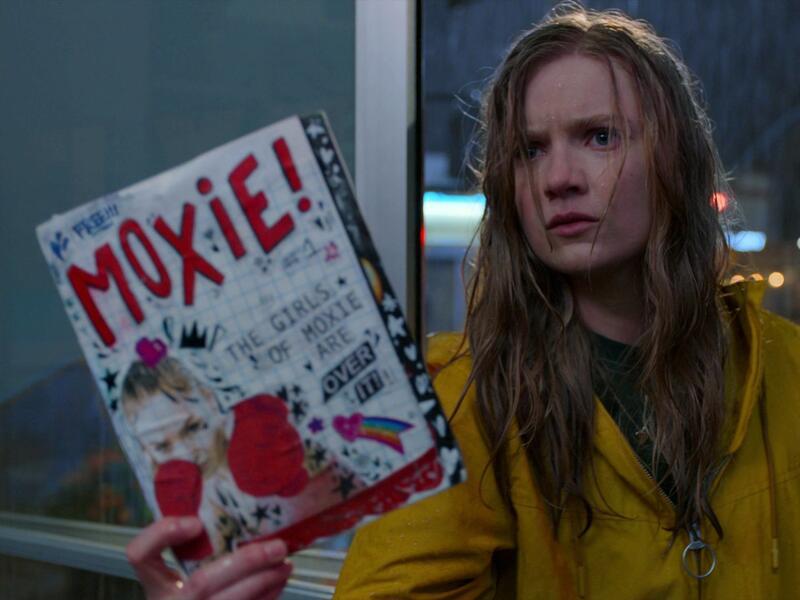"Moxie" Is More than Fiction
In Amy Poehler’s new coming-of-age movie, Moxie, shy and soft-spoken sixteen-year-old Vivian (Hadley Robinson) comes into her own as a young feminist. Inspired by her mom’s activist past and by confident new girl Lucy (Alycia Pascual), Vivian anonymously creates and distributes a disruptive zine, titled Moxie, which calls out sexism at her high school.
More so than many of its predecessors in the teen movie genre, the film succeeds at realistically depicting the issues and challenges high school girls face. Having worked for years with the Jewish Women’s Archive’s Rising Voices Fellows, I’ve witnessed the impact that the patriarchy, and all its trappings, have on young women today. My fear is that some audiences watching this movie may think the challenges Moxie portrays are unrealistic or overblown. I’m here to say that they’re not. With that, I give you five scenarios from Moxie that 100 percent happen to high school girls in real life:
Harassment from boys at school
This is a theme that comes up again and again throughout Moxie. In one particular scene, star football player Mitchell (Patrick Schwarzenegger) interrupts Lucy in class when she challenges the teacher for assigning The Great Gatsby, even though there are other books that portray the American experience in more diverse and inclusive ways. Lucy’s experience with Mitchell is a classic example of mansplaining, and it also happens in real life. Maya Jodidio, a former JWA Rising Voices Fellow, wrote a blog post in 2016 in which she detailed the difficulties of being a high school girl interested in math and science. She explained: “High school boys often try to explain physics or calculus problems to me in a way that clearly implies they think I have no idea what I’m doing. Sometimes a classmate asks me a science question and almost immediately a male peer nearby says, ‘Don’t worry! I can explain this if she can’t!’”
Later on, Mitchell confronts Lucy at a vending machine and puts his hand on her without her consent. When she tells him not to touch her, he grabs her drink and spits in it. A 2011 study published by (American Association of University Women) AAUW found that of the almost 2,000 students surveyed nearly half, 48 percent, experienced some form of sexual harassment that school year. The study also found that girls were more likely to experience sexual harassment than boys: 56 percent versus 40 percent. And keep in mind that this study only covers sexual harassment, not all forms of harassment.
Being dress-coded
At one point in the movie, a young woman is pulled out of class by the principal and sent home for wearing a tank top. The girl next to her was also wearing a tank top, but she wasn’t body-shamed or pulled out of class because she was smaller-chested. This kind of sh*t happens all the time in real life. The Instagram account BeingDressCoded provides example after example of students, especially girls, who have been punished for violating dress codes. Dress codes contribute to the sexualization of young women’s bodies and communicate that boys’ learning is more important than girls’ learning, as girls are often pulled out of class for “distracting” boys. In addition, dress codes are racist, as evidenced by numerous examples, including one in which a Black girl in the UK was repeatedly sent home for having an afro. Dress-code foolery is also a prime example of how adults who should be supporting young women continually fail them by upholding patriarchal and white supremacist norms.
Boys making lists that rank girls based on hotness
This is a fun one, isn’t it? In the fictional high school in Moxie, each year the boys publish a list in which they pick girls as winners for categories such as “most bangable,” “best ass,” and “best rack.” If only this didn’t actually happen in real life, but it does. This 2019 Washington Post article discusses many examples of high school sexual harassment, including a case of teenage boys at a Maryland high school ranking girls based on their appearance. Another former Rising Voices Fellow, Shira Small, wrote a piece in 2017 detailing how, when she was a sophomore in high school, the freshman boys created a March Madness style bracket that evaluated all the girls in the school based on looks. She described: “The day the bracket went public, I saw a girl who had been ranked 60th run into the bathroom, tears rushing down her face. Moments later, a girl who was ranked seventh followed suit. It didn’t matter where you ranked; learning your friends had been judging you solely based on your appearance hurt no matter what.” Think this ends with high school? Think again. Mark Zuckerberg’s pre-Facebook website, Facemash, allowed college students to rank their classmates based on appearance. If you were looking for another reason to hate Mark Zuckerberg, you’re welcome.
Fetishization of girls of color
In Moxie, we learn that a student of color, Kiera (Sydney Park), always wins “best ass” in the boys’ ranked list of the girls in their class. In a similar vein, Lucy briefly discusses the phenomenon of people touching Black girls’ hair without their permission. Unfortunately, examples like these of girls of color being sexualized in racially specific ways are not the stuff of fiction. In a February Forbes article, author Janice Gassam Asare explains: “Fetishization can be thought of as the act of making someone an object of sexual desire based on some aspect of their identity.” She goes on to say: “Saying that you want to associate with someone or date them only because of the racial/ethnic group that they belong to or some aspect of their racial identity may be a good indication that you are engaged in fetishization.”
Seeing male harassers and assaulters protected
In Moxie, the school principal dismisses Lucy’s claims that Mitchell is harassing her. We also find out later that Mitchell had previously raped another girl; she didn’t report it for fear of the ramifications, and we don’t see him suffer any consequences. Ever heard of Brock Turner?
Moxie isn’t perfect. I would’ve liked to see a deeper exploration of the roles whiteness and white supremacy play in white girls’ feminist awakenings. Vivian is moved to action in large part because of her early encounters with Lucy, the new Black girl in school, but it’s Vivian’s story that’s centered, and she receives most of the glory, which is problematic. I also would’ve liked to see greater representation of the experiences of disabled girls, fat girls, and queer girls. There is one disabled character, Meg (Emily Hopper), but her presence could’ve been highlighted more, and the lack of body diversity in the cast is noticeable, as is the almost complete absence of the specific issues faced by fat girls and queer girls.
That being said, I maintain that Moxie presents viewers with a window into some of the real-life challenges that teenage girls confront every day, and that these are issues we should all take seriously. This movie also shows that teen girls are tough. Teen girls are resilient. Teen girls raise their voices against injustice. Teen girls are not to be underestimated. Teen girls have moxie.
And, just think what they could do if they didn’t have to deal with all this patriarchal, white supremacist bullsh*t.








As always, Larisa nails it in this piece. It's unacceptable that teen girls (and grown women too) still have to deal with this crap.